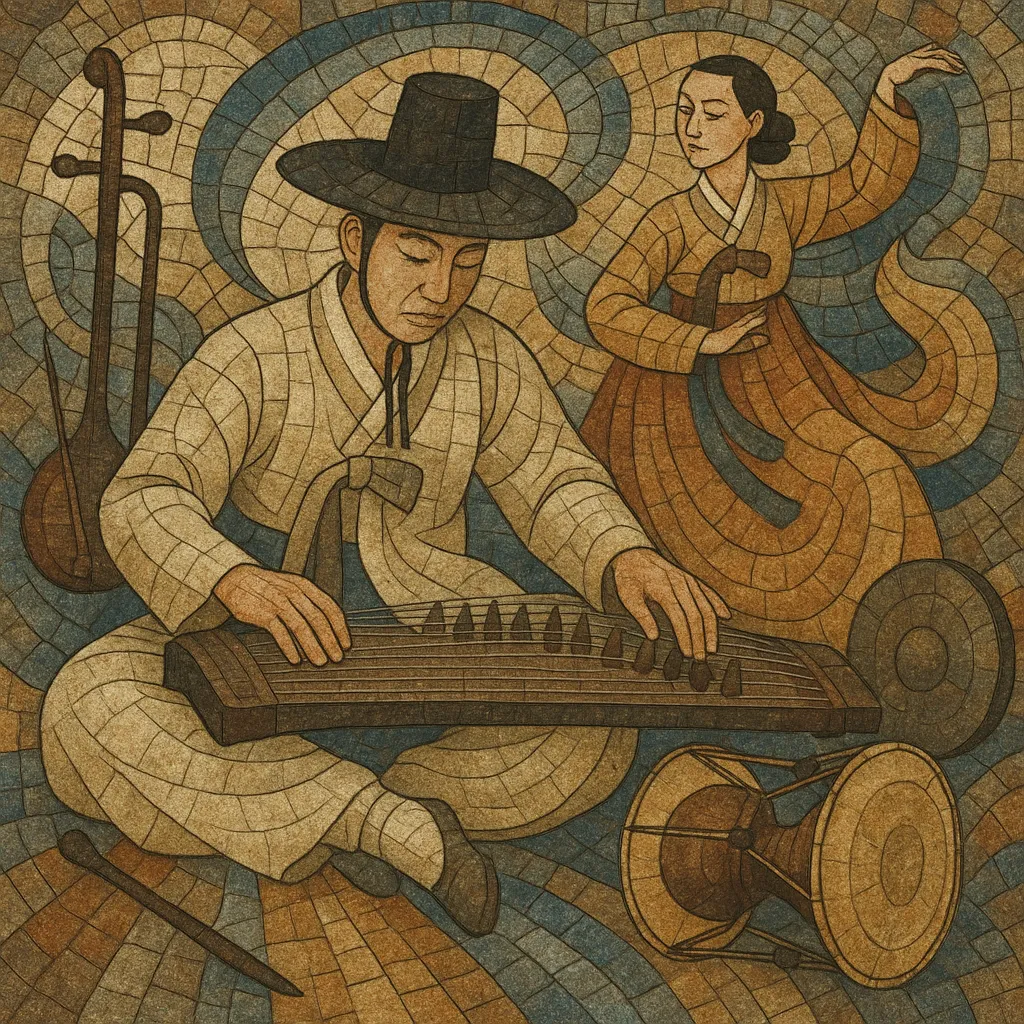
Korean classical music (gugak/gūkak) refers to Korea’s indigenous "art" and court traditions, including ritual, courtly, scholarly (jeongak), and refined folk-derived forms that were codified over centuries.
It features distinctive modal systems (pyeongjo, ujo, gyemyeonjo), cyclical rhythms (jangdan such as jinyangjo, jungmori, jungjungmori, gutgeori, eotmori, hwimori), and signature pitch inflections and ornaments known as sigimsae. Textures are largely monophonic or heterophonic, with great emphasis on timbre, breath, and expressive nuance.
Core instruments include gayageum and geomungo (zithers), haegeum (fiddle), piri and taepyeongso (double reeds), daegeum and sogeum (flutes), ajaeng (bowed zither), and percussion such as janggu (hourglass drum), buk, jing, and kkwaenggwari. Repertoires range from Confucian shrine and royal ancestral rites (Jongmyo/Munmyo jeryeak) to elegant chamber suites (e.g., Yeongsanhoesang) and later virtuosic offshoots like sanjo.
Korean classical music crystallized as a state-supported art during the Goryeo dynasty, when imported Confucian ritual music (aak) from Song China was institutionalized alongside indigenous court pieces (hyangak). Earlier foundations reach back to the Three Kingdoms and Unified Silla eras, but Goryeo’s adoption and systematization of court rites gave the tradition durable form.
Under the Joseon dynasty, Confucian governance elevated ritual and court repertories, especially the royal ancestral rites (Jongmyo jeryeak) and Confucian shrine music (Munmyo jeryeak). Court and literati music (jeongak) flourished, emphasizing restraint, balance, and moral cultivation. The invention and dissemination of the jeongganbo square-notation system in the 15th century further standardized pitch, rhythm, and structure. Buddhist chant (beompae) and indigenous practices continued in parallel, enriching the broader classical soundworld.
From the late Joseon period, classically grounded yet more extrovert forms like sanjo (instrumental solo with janggu accompaniment) and sinawi (improvisatory ensemble practice) developed, fusing classical modes and jangdan with folk vitality. In the 20th century, colonization, war, and modernization disrupted patronage, but post-war cultural policy fostered preservation and transmission through national institutions and Intangible Cultural Heritage designations.
Today, the National Gugak Center and city orchestras sustain ritual, court, and chamber repertoires while composers and performers create changjak gugak (newly composed works) and cross-genre fusion. International collaborations and education have broadened the audience, yet the core aesthetics—modal color, cyclical time, and expressive ornamentation—remain central.
Select a core of traditional instruments: zither (gayageum or geomungo), winds (piri, daegeum, sogeum), fiddle (haegeum), bowed zither (ajaeng), and percussion (janggu, buk, jing, kkwaenggwari). For court/jeongak aesthetics, use a restrained chamber ensemble; for ritual textures, expand with large winds and percussion.
Base melody on pyeongjo, ujo, or gyemyeonjo pentatonic frameworks. Treat pitches flexibly with sigimsae—slides, appoggiaturas, microtonal inflections, and timbral vibrato—to shape each tone as a living gesture. Favor long tones, controlled breath, and timbre as expressive parameters.
Organize time with cyclic jangdan: very slow jinyangjo to establish gravitas; medium cycles like jungmori and jungjungmori for balanced flow; gutgeori for lilting 12/8 swing; eotmori and hwimori for asymmetry and acceleration. Develop form in large arches—slow introduction, gradual intensification, then repose—rather than verse–chorus symmetry.
Write primarily monophonic or heterophonic textures. Avoid Western functional harmony; instead, use drones, register doubling, and heterophonic variation. Embrace yoyu (spaciousness): allow silence and decay to articulate phrases and cycles.
Sketch with jeongganbo-style grids (or modern staff/number notation) but rehearse orally to internalize mode, jangdan, and ornament. Balance fixed melodic kernels with measured improvisation, especially in sinawi- or sanjo-like passages.
In changjak gugak, enrich timbre with extended techniques (multiphonics on piri, breathy tones on daegeum, percussive pizzicato on gayageum) or subtle electronics, while preserving modal identity and cyclical rhythm.

